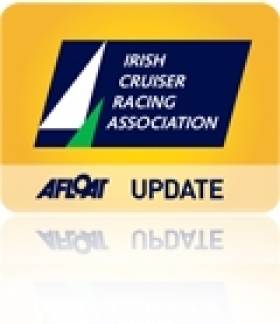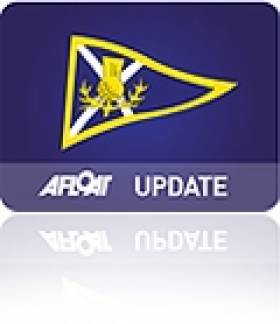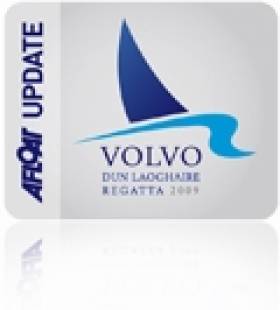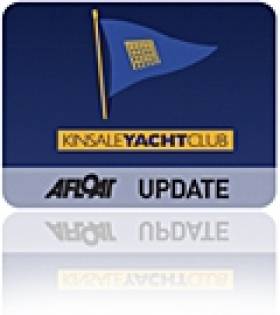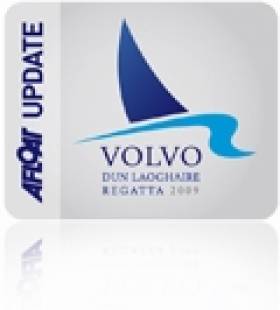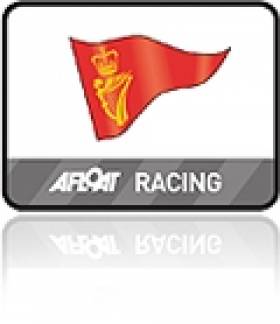Displaying items by tag: Royal Cork
ICRA Racing Underway in Crosshaven
Kinsale Heads for 100-mile Fastnet Race
Kinsale Yacht Club's SCORA League Fastnet Race sponsored by CH Marine takes place this Friday at 8pm.
This 100–mile round trip to one of the most iconic ocean racing turning points presents all the challenges to competitors associated with classic offshore/coastal racing.
The many headlands along the track present major tactical decision points for skippers and navigators in their race to make the many tidal gates along the route. This coupled to the often fickle winds make the creation of a race winning strategy extremely difficult.
This now classic race on the South Coast typically attracts competitors from the host Club Kinsale Yacht Club along with competitors from the Royal Cork and Cobh Sailing Club.
The inclusion of the Kinsale Fastnet in SCORA Jim Donegan Memorial Series enhances the standing of this race along the South coast and the very generous sponsorship of this race by CH Marine makes the race highly attractive for South coast sailors.
Intending competitors are reminded that this is a ISAF OSR Cat 3 race with life rafts. Safety checks may be conducted prior to the start.
The conditions were ideal with a 7–knot breeze coming from the S.E. with flat water, blue skies and at the top of the tide. The harbour was looking its best.
The Race Officer set an excellent course. A bit of bias on the line made the start a bit interesting though. Class One got away clean. But Classes two and three had a General Recall.
After the start at Grassy the fleet had a beat out to No.3 The usual debate ensued over which side of the course was favoured. It was a close call in the end. Around No. 3 to starboard, spinnaker up and back to the Cage Bouy. A gybe and then on to No.12 at this stage there was a nice bit of ebb in the tide. It really was a case off keeping the Spinny flying for as long as possible up to the Mark. A nice beat followed, down to Corkbeg and then a nice reach back to the Grassy where the S flag was flying.
It was a good night for Billy Duane in his Sunlight 30 Expression in the White Sail fleet and for Jimmy Nyhan and Maritta Buwalda in their 1/4 Tonner Outrigger in Class 3.
First places also went to Thunderbird a Corby 25 owned by Denis Coleman in Class 2 and Endgame an A35 owned by Frank Doyle in Class 1.
O'Leary Hunts for Third Scottish Title
Royal Cork's Anthony O'Leary, who has won the Scottish Series award twice, is in Tarbert bidding to win for a third time 30 years exactly since the Trophy first went to Ireland when it was won by Frank Woods on the Castro designed One Tonner Justine III. This year Irish travellers to Scotland are down as is the overall attendance for tomorrow's event.
For all that the total entry may have compacted down in recent years due largely to the pressures of the global economy and the net consequence of more carefully allocated holiday or leisure times, the core entry for the Brewin Dolphin Scottish Series is as richly laden with high quality talent and past winners as ever.
The north of Britain's most prestigious annual sailing regatta starts Friday morning and the 107 crews look like they are in for more breezy weather on Loch Fyne. Of course over more than 30 years of racing on the loch, strong winds are nothing new.
Regulars who year in year out set aside the May Bank Holiday weekend to race on the spectacular waters of the sea loch, have returned to work each Tuesday as often with sunburn as they have borne the obvious effects of four days in unrelenting wind and chilly temperatures.
But the majority of these next few days seem set to be given over to the latter.
It will matter little to the hard core. Four skippers will be looking to match Jonathan Anderson's record of three overall Scottish Series wins. Perhaps the best chance of achieving this hallowed hat-trick rests again with Hamish Mackay who won in consecutive years 2001 and 2002.
Ten years on from that last win Mackay, past Chairman of the Royal Yachting Association will be helping campaign a J97 Jackaroo in IRC Class 4, which recently dominated at the warm-up Savills Regatta on the Clyde winning the overall top trophy.
Clyde sailmaker John Highcock is also bidding for a third win of the overall top award, after helping veteran John Corson to secure the Brewin Dolphin Scottish Series Trophy last year with his Corby 33 Salamander XX. The same team which won last year remains intact, with the boat unchanged from victory last May.
Chris Bonar, who won in 1985 and 1997, returns with his crew on Bateleur 97, a BH36 which competes in IRC Class 1 up against Anthony O'Leary, from Royal Cork YC, who has also won the top award twice.
Racing starts Friday for all classes and concludes Monday.
"It looks like it will be a nice compact regatta during which we can maximise our ability to run good racing, and the amenity values of Tarbert will be at their highest. It is gratifying to see that the IRC and the CYCA Handicap classes' entries have stood up well. And after the event we will look a little closer at why the entries for some of the sporstboat and smaller one design classes are down," said John Readman, chair of the Brewin Dolphin Scottish Series organisers the Clyde Cruising Club.
Regatta Entry Deadlines Looming
Deadlines for entry in to a number of this season's key sailing regattas are looming. Volvo Dun Laoghaire Regatta's significantly reduced early bird entry rate for the July 7th event will end on Monday and offshore racers intending to race in June 11th's 320-mile Dun Laoghaire to Dingle Race must enter by next Friday 20th. The ICRA Cruiser Championships in Crosshaven takes place from the 17th to 19th June, a fixture that suits those boats intending to compete in the Dingle race. Race details can be downloaded below.
Royal Cork's Seafra Guilfoyle consolidated his position at the top of the Laser 4.7 fleet with a second and sixth placing in day Two of the Mitsubishi Youth Nationals.
Dublin Bay presented more challenging conditions for the 300 sailors than yesterday. (Scroll down for Gareth Craig's photos). The day started with a 12-14 knot north easterly breeze with a big swell. Big wind shifts and dropping to 2-3 knots meant that not all fleets completed all races scheduled for the day. On the yellow course the Laser Radials, Laser 4.7s and the 420s only completed two races.
On the orange course the Topper fleet only had two races whilst the Fevas completed three races. The Optimist trials on the Blue course completed all three races.
In really challenging conditions, sailors that were consistent did remarkably well such as Sophie Murphy who is the leading girl in the Laser Radial class and Christopher Eames also in the Laser Radial class who had a first and a third. It was a good day for the brother and sister crews in the 420 fleet. The Crosbies from Royal Cork YC won both races and the Dalys from Tralee Bay SC were second in the first race.
Provisional results as follows:
Yellow Course (Laser Radial, Laser 4.7, 420)
Laser Radial : (5 races completed) 1. Philip Doran Courtown SC 2. Eoin Keller, Lough Derg YC 3. Robbie Gilmore, Strangford Lough YC
Laser 4.7: (5 races completed) 1. Seafra Guilfoyle, RCYC, 2. Darragh O'Sullivan Kinsale YC, 3. Fin Lynch, Blessington SC
420: (5 races completed) 1. Emma Geary & Niamh Connolly (RCYC & Baltimore SC), 2. Patrick Crosbie & Chloe Crosbie, (RCYC) 3. Tara Flood & Lucy Bolger (Howth YC & RSGYC)
Blue Course (Optimist National Trials, First leg completed in Kinsale )
Optimist (11races completed) 1. Sean Donnelly, National YC, 2. Sophie Browne, Tralee Bay SC, 3. Harry Whitaker, Royal Cork YC.
Orange Course (Topper & Optimist & Feva)
Feva: (3 races completed) 1. D Johnston & L Flynn Byrne, Howth YC. 2. C Totterdell & S Craig, National YC/Royal St George YC, 3. C Mollard & J Harris, Howth YC
Topper: (5 races completed) 1. T Brow, Ballyholme YC, 2. Laura Gilmore, Strangford Lough YC, 3. Lucy Burrows Donaghdee SC,
Optimist: (Championship fleet, 1 race completed) 1. R Quirke, National YC, 2. C O'Sullivan, Malahide YC, 3. Jacob Martensson, Royal Irish YC,
For the sailors, this event is the most important in the annual calendar as it is the decider for the youth national titles and for sailors to compete internationally during 2011 and is the pathway for future Olympic sailors.
More photos on the gallery here
100 Boats Sailing in for July's Dun Laoghaire Regatta
Royal Cork's Anthony O'Leary, Afloat.ie's Sailor of the Year, is an early entry for July's Volvo Dun Laoghaire Regatta that has already attracted 100 entries, 50% of which are come from outside the Dublin Bay area.
The hope is O'Leary (who will be sailing Antix Beag) will be joined by a Crosshaven club mate Conor Phelan (sailing Jump), both are previous cruiser class winners in the 17-division championships that starts this year on July 7.
The biennial event, hosted by all four waterfront clubs, prides itself as Ireland's biggest sailing event. Seven nations and 32 yacht clubs are represented. So far 14 clubs are coming from England, two from Scotland, two from Wales, one from the Isle of Man and one from France.
The massive event that is expecting up to 500 entires is chaired this time by local sportsboat sailor Adam Winkelmann.
Dublin clubs have not been slow to enter early either. As expected Dun Laoghaire's own waterfront leads the way; The Royal Irish YC has 19, the National YC has 11, the Royal St George YC nine and the Dun Laoghaire Motor YC three entries.
An early entry discount is in operation for the next 28 days only. Enter here.Click this link for the latest Dun Laoghaire Regatta.
Join the Regatta on Afloat's facebook page here.
Thirty Enjoy Kinsale's Frostbite Finale
Conditions for the final day of the ASM-Marine Frostbite League at Kinsale Yacht Club on Sunday could not have been a more inviting finale for the thirty plus sailors competing in the Laser, Squib and Mixed Dinghy Fleets. Despite losing two of the six week series due to the weather, the last day of the season brought welcome sunshine accompanied by a fresh Force 4 North to North-Westerly breeze, gusting Force 5 at times. Three windward-leeward races were completed which brought the total race number to eleven, with two discards applying. The constantly shifting Northerly breeze, which tracked slowly westwards was the predominate feature in all three races, with an ebb tide having effect to the right hand side of the coarse.
Dara O'Shea (KYC) with another gritty performance in the Laser 4.7 fleet, managed this week to overhaul the league leader Cian Byrne (KYC/RCYC). Leaving it to the final race and with both sailors on nineteen points, Dara grasped the top spot as he fought off his rivals and eventually took line honours and the Laser 4.7 League title. Cian untypically finished fourth but nevertheless secured second place overall, just two points behind. Darragh O'Sullivan had an excellent day's racing with a win and two seconds which pulled him into third place overall, just ahead of Conor Murphy (KYC) who finished on the same points total but one place behind in the final race.
Proving once again that consistency is the key to success in the Frostbite League, Eoghan Cudmore (KYC) with a fifth, third and a second in the Radial Fleet managed to hold off the challenge for the top spot from last year's winner Sean Murphy (KYC) who scored two thirds and a fourth. With the second best results of the day, Colm O'Regan (KYC) scoring two seconds and a fourth, moved up to third place overall. Despite an excellent run of results with three wins on the final day Thomas Chaix (KYC) with insufficient points accrued could not make an impact on the final order.
In the Laser Standard Class Rob Howe (RCYC) continued his outstanding form with a further second place and two firsts bringing his overall total to an unassailable eleven points, fourteen points ahead of his nearest rival Paul O'Sullivan of Monkstown. Scoring two thirds and a second, O'Sullivan's consistent form paid off bringing him into second place overall. David Kenefick (RCYC) who had closely pursued the leader throughout the series, dropped to third place overall as he did not compete on the day.
Seldom conceding line honours Marcus Hutchinson and Ben Fusco (KYC) in the Squib Class went into the final day leading comfortably by eight points. Two wins later and a final second easily secured the league title and are now the new holders of the Bruce Mathews Squib Trophy. In a repeat of last year Paul McCarthy (KYC) finished strongly with two seconds and a win in the final race. These results elevated him from fourth place overall into the prize winning second position. Victor Fusco and Ruth Ennis (KYC) with a final third, fourth and seventh subsequently slipped one place to claim the third prize overall.
In the Mixed Dinghy Class, despite conceding line honours in all three races Brian Jones and Gary Frost (MBSC) in their International 505 finished the series as the lead boat four points comfortably ahead. The RS Feva of David Marshall and Rob Scandrett (RCYC) closed on a high note as they took advantage with three win ASM-Marine KYC Frostbite League - Sunday 27th Feb, 2011.
Conditions for the final day of the ASM-Marine Frostbite League at Kinsale Yacht Club on Sunday could not have been a more inviting finale for the thirty plus sailors competing in the Laser, Squib and Mixed Dinghy Fleets. Despite losing two of the six week series due to the weather, the last day of the season brought welcome sunshine accompanied by a fresh Force 4 North to North-Westerly breeze, gusting Force 5 at times. Three windward-leeward races were completed which brought the total race number to eleven, with two discards applying. The constantly shifting Northerly breeze, which tracked slowly westwards was the predominate feature in all three races, with an ebb tide having effect to the right hand side of the coarse.
Dara O'Shea (KYC) with another gritty performance in the Laser 4.7 fleet, managed this week to overhaul the league leader Cian Byrne (KYC/RCYC). Leaving it to the final race and with both sailors on nineteen points, Dara grasped the top spot as he fought off his rivals and eventually took line honours and the Laser 4.7 League title. Cian untypically finished fourth but nevertheless secured second place overall, just two points behind. Darragh O'Sullivan had an excellent day's racing with a win and two seconds which pulled him into third place overall, just ahead of Conor Murphy (KYC) who finished on the same points total but one place behind in the final race.
Proving once again that consistency is the key to success in the Frostbite League, Eoghan Cudmore (KYC) with a fifth, third and a second in the Radial Fleet managed to hold off the challenge for the top spot from last year's winner Sean Murphy (KYC) who scored two thirds and a fourth. With the second best results of the day, Colm O'Regan (KYC) scoring two seconds and a fourth, moved up to third place overall. Despite an excellent run of results with three wins on the final day Thomas Chaix (KYC) with insufficient points accrued could not make an impact on the final order.
In the Laser Standard Class Rob Howe (RCYC) continued his outstanding form with a further second place and two firsts bringing his overall total to an unassailable eleven points, fourteen points ahead of his nearest rival Paul O'Sullivan of Monkstown. Scoring two thirds and a second, O'Sullivan's consistent form paid off bringing him into second place overall. David Kenefick (RCYC) who had closely pursued the leader throughout the series, dropped to third place overall as he did not compete on the day.
Seldom conceding line honours Marcus Hutchinson and Ben Fusco (KYC) in the Squib Class went into the final day leading comfortably by eight points. Two wins later and a final second easily secured the league title and are now the new holders of the Bruce Mathews Squib Trophy. In a repeat of last year Paul McCarthy (KYC) finished strongly with two seconds and a win in the final race. These results elevated him from fourth place overall into the prize winning second position. Victor Fusco and Ruth Ennis (KYC) with a final third, fourth and seventh subsequently slipped one place to claim the third prize overall.
In the Mixed Dinghy Class, despite conceding line honours in all three races Brian Jones and Gary Frost (MBSC) in their International 505 finished the series as the lead boat four points comfortably ahead. The RS Feva of David Marshall and Rob Scandrett (RCYC) closed on a high note as they took advantage with three wins and claimed the second prize overall. Finishing third on the day and third overall in the series was the Feva of Fiona Lynch and Sofie Kelleher.
At the Prize Giving, Alice Kingston KYC Commodore, congratulated the deserving winners and thanked all the sailors for their efforts. Special thanks went to PRO Bruce Mathews for his dedicated support, the Organisers, the Sponsor ASM-Marine and all those who had helped both on and off the water to make this annual event such a success. Cameron Good KYC Vice-Commodore presented the prizes and June Matthews presented the Bruce Matthews Trophies for the best performances in the Laser Radial and Squib Classes won by Eoghan Cudmore and Marcus Hutchinson respectively. The inaugural Laser 4.7 'Destiny' Trophy was presented to Dara O'Shea.
- ASMMarine
- Kinsale
- yacht
- Club
- Frostbite
- Dara O'Shea
- Cian Byrne
- Darragh O'Sullivan
- Conor Murphy
- Eoghan Cudmore
- Colm O'Regan
- Sean Murphy
- Ben Fusco
- Marcus Hutchinson
- squib
- Paul McCarthy
- Ennis
- Ruth
- Dinghy
- Cameron Good
- Ruth Ennis
- Fiona Lynch
- Sofie Kelleher
- David Marshall
- Laser
- David Kenefick
- RCYC
- Royal Cork
Entries Roll in for Volvo Dun Laoghaire Regatta
Forty entries are already in for Volvo Dun Laoghaire Regatta, a fixture widely expected to be the biggest in Ireland this season when it sets sail on Dublin Bay in July.
Organisers are expecting up to 500 boats to keep it on a par with the 2009 event. The early entries, 11 weeks ahead of the entry deadline, is being taken as a thumbs up by competitors for the fun and vlaue theme of this year's VDLR.
So far 22 different clubs have entered from six countries. The bulk of the fleet is Irish but there are early entries from France, Isle of Man, UK, Wales and Northern Ireland. Another good turnout is exepcted from Liverpool and Holyhead for boats competing in the IRC Lyver Cup Race across the Irish Sea. Ten boats from the Clyde will also compete on the Bay.
Cork's Conor Phelan the skipper of Jump Juice is one of the first Royal Cork boats confirmed.
Two handed IRC racing makes its debut in July's Volvo Dun Laoghaire Regatta organisers have also confirmed. Click HERE.
On the dinghy front, the Fireball class has confirmed it will be running an'Open Championship' within the regatta, an event that follows the class world championships in Sligo in June.
National 18s Aim for Big Turn-Out
The club hopes over 50 boats will participate across three separate divisions:-
Ultimates - The modern fibreglass boats of the racing fleet.
Penultimates - The older fiberglass boats that have been hiding in garages waiting to be taken out for the 2011 championship.
Classics - The beautiful wooden clinker-built boats that have re-surfaced in Crosshaven, West Cork and further afield in recent years.
More on this class by Tom MacSweeney HERE



























